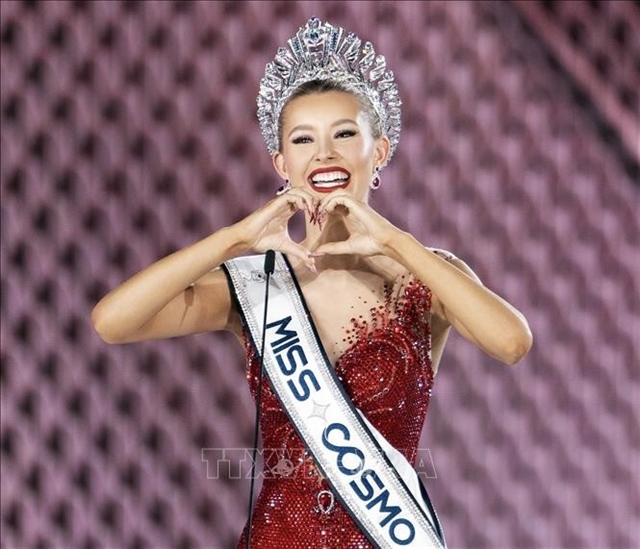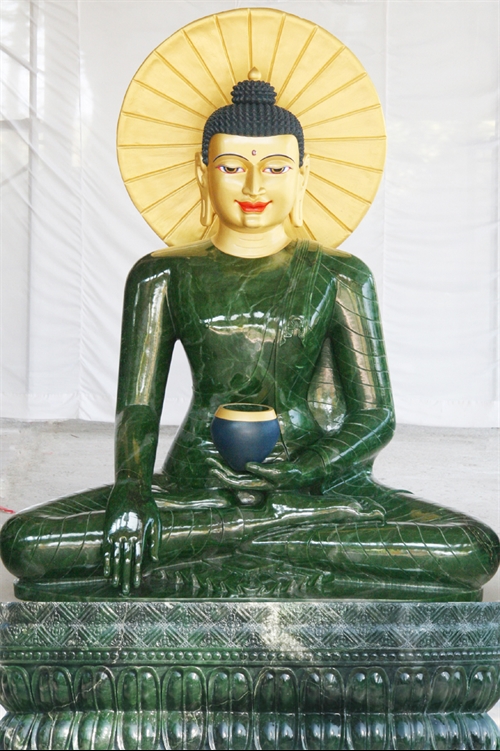 Life & Style
Life & Style

The world’s largest Buddha statue, made of jade, has been brought to Việt Nam. It will be displayed soon in the central Quảng Bình Province before it is exhibited in other northern localities.
 |
| World’s largest: The “Jade Buddha for Peace” statue will soon be exhibited at Hoang Phuc Pagoda, in the central province of Quang Binh. Photo giacngo.vn |
HÀ NỘI – The world’s largest Buddha statue, made of jade, has been brought to Việt Nam.
It will be displayed soon in the central Quảng Bình Province before it is exhibited in other northern localities.
A solemn ceremony to welcome the statue will be organised at Hoằng Phúc Pagoda in Quảng Bình at 9am on March 27. The statue will be displayed there till April 5, while various worship ceremonies for national peace and security and lectures on Buddhism and peace will be hosted by senior Buddhist monks Thích Đức Thiện and Thích Chân Quang.
The “Jade Buddha for Peace” statue has been carved from gemstone-quality jade called Polar Pride, discovered in north Canada in 2000. Ian Green, an Australian Buddhist, had invited artisans from Nepal, India and Thailand to carve the statue in Thailand.
The statue is modelled on the Siddhartha Gautama Buddha statue inside the Mahabodhi Stupa in India’s Bodh Gaya. It stands 2.7m tall, weigh four tonnes and sits on a 1.4m-high solid alabaster throne. Its size and beauty make it a wonder of the world.
The statue was first displayed in various pagodas in Việt Nam such as in the central city of Đà Nẵng, Bà Rịa Vũng Tàu, HCM City and Đồng Tháp in the south, besides the northern Bắc Ninh Province in 2009.
It was then moved to Australia before it toured the United States (2010), Europe (2011) and Asia (2012).
According to monk Thích Đức Thiện, head of Hoằng Phúc Pagoda in the central Quảng Bình Province, the statue was first displayed in Việt Nam as “the Vietnamese people love peace and believe in Buddhism, and thanks to the great support of Vietnamese enterprises in Australia.”
It’s reported that after being brought to Việt Nam for the second time this year, the Jade Buddha will be permanently installed in Australia.
Hoằng Phúc is an ancient pagoda associated with King Monk Trần Nhân Tông (1258-1308), the third King of the Trần Dynasty (1226-1400) and the founder of the Trúc Lâm Zen Buddhist sect in Việt Nam.
The pagoda was called Tri Kiến (or Kính Thiên) at first and is located in Thuận Trạch Village in Lệ Thủy District’s Mỹ Thuỷ Commune.
King Monk Trần Nhân Tông gave lessons on Buddhism at the pagoda in 1301.
According to historical books, lords Nguyễn Hoàng and Nguyễn Phúc Chu renovated the pagoda in the 17th century.
“The renovation marked the period when our ancestors expanded the territory to the south,” Thiện said.
On the occasion of welcoming the jade statue, the pagoda would distribute a “holy paper” containing the teachings of King Monk Trần Nhân Tông, Thiện said.
Organisers will also prepare up to 10,000 vegetarian food portions each day for tourists flocking to the pagoda during the time.
While local localities have upgraded local infrastructure facilities for tourists, the organisers are encouraging local households to offer overnight home-stay services to tourists. Those who would like to stay longer in the locality could travel to Đồng Hới City for hostel and hotel accommodation, Thiện said. – VNS




